
About UsThe Numismatic Bibliomania Society is a non-profit organization promoting numismatic literature. For more information please see our web site at coinbooks.org SubscriptionsThose wishing to become new E-Sylum subscribers (or wishing to Unsubscribe) can go to the following web page link MembershipThere is a membership application available on the web site Membership Application To join, print the application and return it with your check to the address printed on the application. Membership is only $15 to addresses in the U.S., $20 for First Class mail, and $25 elsewhere. For those without web access, write to: David M. Sundman, Secretary/TreasurerNumismatic Bibliomania
Society AsylumFor Asylum mailing address changes and other membership questions, contact David at this email address: dsundman@LittletonCoin.com SubmissionsTo submit items for publication in The E-Sylum, just Reply to this message, or write to the Editor at this address: whomren@coinlibrary.com
BUY THE BOOK BEFORE THE COINYou won't regret it! |
- WAYNE'S WORDS: THE E-SYLUM JULY 1, 2012
- NBS EVENTS AT THE 2012 PHILADELPHIA ANA SHOW
- NEW BOOK: SURPRISING HISTORY OF THE 1838-O HALF DOLLAR
- NEW BOOK: GUIDE BOOK OF PEACE DOLLARS, 2ND EDITION
- NEW BOOK: 2013 STANDARD CATALOG OF WORLD COINS 2001-DATE
- THE ORIENTAL NUMISMATIC SOCIETY
- EL SITIO NO. 3 PUBLISHED BY THE INSTITUTO URUGUAYO DE NUMISMATICA
- MONNAIE MAGAZINE AVAILABLE ON THE INTERNET
- COLORADO SPRINGS FIRE UPDATE
- LAURENCE BROWN, 1931-2012
- EDITH SCHÖNERT-GEIΒ, 1933-2012
- NOTES FROM E-SYLUM READERS: JULY 1, 2012
- VOCABULARY PHRASE: IN GOOD NICK
- MORE ON THE MEDAL OF THE MONTH
- HIDDEN COINS: HERBERT DIETZ AND MARTIN KORTJOHN
- DICK JOHNSON ON STOLEN VALOR: MEDAL CHEATS TRIUMPH
- QUERY: IS IT STILL ILLEGAL TO BUY AND SELL MEDALS OF HONOR?
- MORE ON THE GILBERT PAPER COMPANY
- REQUEST: ELECTRONIC NBS MEMBERSHIP
- QUERY: JULIO KILENYI'S CRANFORD CIVIC AWARD MEDAL SOUGHT
- BRITISH MUSEUM MONEY GALLERY REOPENS
- BOSTON'S MUSEUM OF FINE ARTS TO EXHIBIT ANCIENT COINS
- HARVEY STACK ON THE PHILADELPHIA MINT ELIASBERG COLLECTION EXHIBIT
- REVAMPED PHILADELPHIA MINT EXHIBIT AND TOUR OPENS
- ANS AND ANA PLANNING JOINT EXHIBIT ON PHILADELPHIA MINT COINAGE
- ARTICLE PROFILES DR. ARNOLD R. SASLOW
- MASSIVE COIN HOARD UNEARTHED IN JERSEY
- QUERY: OVERSTAMPS ON U.S. BANKNOTES
- COUNTERFEIT BANKNOTES BEING SPENT IN TOURIST AREAS
- PERTH MINT'S AUSTRALIAN KANGAROO GOLD COIN ENTERS GUINNESS BOOK
- MONTROVILLE W. DICKESON'S PANORAMA ON DISPLAY IN ST. LOUIS
- HOME LIBRARIES: BACK IN STYLE!
- FEATURED WEB PAGE: BRITISH HISTORICAL MEDALS 1760-1960
WAYNE'S WORDS: THE E-SYLUM JULY 1, 2012

New subscribers this week include Paul Belschner, courtesy of Russ Sears, and Gerry Peacock. Welcome aboard! We have 1,563 email subscribers, plus 182 followers on Facebook.
A wide swath of the U.S. was subjected to heavy storms over the weekend. We had a couple shutters blow off our house here in Virginia and had damage to the canopy of our kids' playhouse, but luckily we had no serious damage and didn't lose our power. But many people nearby are still without power and are camping out in malls, shelters and office buildings. The storm was felt in Ohio, too. David Fanning of Kolbe & Fanning writes:
We're without power because of the storm and it may be late in the week before we're back up. Please let the E-Sylum crowd know this; email access is limited.
This week we open with a note on NBS events at the upcoming Philadelphia ANA show, three new books, and three numismatic society publications. Other topics include collectors Herbert Dietz, Martin Kortjohn and Louis Eliasberg, the Stolen Valor Act, and medallist Julio Kilenyi.
To learn more about the 1838-O Half Dollar, the Oriental Numismatic Society, the new exhibit and tour of the Philadelphia Mint and Montroville W. Dickeson's panorama, read on. Have a great week, everyone!
Wayne Homren
Editor, The E-Sylum
NBS EVENTS AT THE 2012 PHILADELPHIA ANA SHOW
NBS Vice President Marc Ricard writes:
I have the following information from the ANA on the Numismatic Bibliomania society events in Philadelphia:
Thursday, 8/9 NBS Symposium 11:30 a.m. - 1:00 p.m. Room 106A-B (I have not consulted with the rest of the Board on a speaker, but as soon as I know, I will send the information).
Thursday, 8/9 NBS Board Meeting 1:00 p.m. - 2:30 p.m. Room 107A
Friday, 8/10 NBS General Meeting and Auction 11:30 a.m.-1:00 p.m. Room 106AB
As always, this is from the ANA and could change by game time.
Applications are due July 6 to exhibit at the show Aug. 7-11
American Numismatic Association members are invited to showcase their collectibles, research and creativity at the World's Fair of Money in Philadelphia by creating a Collector Exhibit. The show will be held Aug. 7-11 at the Pennsylvania Convention Center. The application deadline for collector exhibits is Friday, July 6.
The Collector Exhibits, a highlight of every ANA show, bring together talented numismatic exhibitors and stunning collections from across the nation. All areas of numismatics are represented, including U. S. coins and paper money, ancient coins, tokens, medals and exonumia.
Exhibitors have the option to enter their displays in competitive (judged), non-competitive, or marquee (invitational) categories. Competitive exhibits are judged on a variety of standards, including educational value, presentation and degree of difficulty.
For a complete list of rules, a schedule of events for exhibitors, and an application form, please go to www.WorldsFairofMoney.com and select "Collector Exhibits" from the right-hand menu.
NEW BOOK: SURPRISING HISTORY OF THE 1838-O HALF DOLLAR
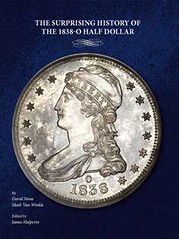 The 1838-O Reeded Edge half dollar is one of the classic rarities in U.S. coinage, from a tiny mintage of "not more than 20 pieces," and now aficionados of the rare variety have a chance to deepen their knowledge of the fabled coins with Heritage Auctions' new booklet, "The Surprising History of the 1838-O Half Dollar," by David Stone, Mark Van Winkle and edited by James Halperin.
The 1838-O Reeded Edge half dollar is one of the classic rarities in U.S. coinage, from a tiny mintage of "not more than 20 pieces," and now aficionados of the rare variety have a chance to deepen their knowledge of the fabled coins with Heritage Auctions' new booklet, "The Surprising History of the 1838-O Half Dollar," by David Stone, Mark Van Winkle and edited by James Halperin.
The slight edition is rich in detail and historical depth, providing not only a compelling read but securing a place for itself among collectors as an indispensible research tool. It can be purchased online by emailing catalogorders@ha.com.
"Despite its long history, and the high prices examples have realized at public auction," said Halperin, "there have always been many questions about the origin and purpose of the 1838-O, since the coins were not mentioned in the official New Orleans Mint report for 1838. This study sheds some light on the surprising history of these important coins."
1838-O Halves have been avidly collected since the mid-19th century. In fact, the specimen in the Smithsonian Institution was one of the earliest donations to the National Numismatic Collection, which originated as the Mint Cabinet in 1838.
"New evidence indicates 1838-O half dollars were struck on two different occasions," said Halperin. "Originals were struck early in 1838 at the Philadelphia Mint as prototypes for a planned New Orleans Mint coinage that never took place due to production difficulties in that facility's first year of operations."
The Philadelphia coins display proof surfaces, with sharply detailed design elements and no evidence of die rust or doubling of devices. Restrikes, however, were struck in January 1839 in New Orleans, to test a new coining press because the 1839-dated dies had not been shipped from the Philadelphia Mint at that time.
"These coins show clear evidence of die rust and profound doubling on some letters and devices," added Halperin, "probably caused by unorthodox placement of the dies in the coining press. The rusted dies indicate that some time passed between the two strikings and the doubling suggests the dies were not secured in the same fashion, causing the dies to bounce when the coins were struck."
The booklet goes into detail about letters found in the National Archives – discovered by R.W. Julian – that outline many of the difficulties encountered by the staff of the New Orleans Mint in 1838, including a first-person account of the New Orleans striking.
Chief Coiner Rufus Tyler wrote to Mint Director Robert M. Patterson, on February 25, 1839, informing him that 10 examples of the 1838-O had recently been coined. After that, Tyler presented one of the coins to his old college professor, Dr. Alexander Bache, along with a note stating "not more than twenty pieces were struck with the half dollar dies of 1838."
The discrepancy between the two mintage figures suggests that Tyler was aware of two different coining events, the 10 coins he struck early in 1839 and the earlier Philadelphia striking in 1838. More evidence about the Philadelphia striking has come to light through a study of 19th century auction descriptions and periodicals.
"We expect the newly discovered dual origin of the 1838-O half dollar to change the way numismatists think about this important coin," said Halperin.
In addition, this paper features major revisions to recent rosters, where findings show only nine specimens of the 1838-O are still extant, instead of the usually listed 11 coins. Images of all known specimens are included, with the individual pedigree of each coin.
NEW BOOK: GUIDE BOOK OF PEACE DOLLARS, 2ND EDITION
Whitman Publishing, LLC, announces the release of the second edition of the Guide Book of Peace Dollars, by award-winning researcher and writer Roger W. Burdette. The 288-page book debuts June 28, 2012, with a suggested retail price of $19.95.
Burdette is the author of the three-part Renaissance of American Coinage, each volume of which has won the Numismatic Literary Guild's "Book of the Year" (2006, 2007, and 2008). He is also a contributor to the Guide Book of United States Coins (the "Red Book"), and has shared research and insight in numerous other Whitman books.
The Guide Book of Peace Dollars is volume 13 in Whitman's "Bowers Series" of numismatic references. It covers every date and mintmark of America's last 90% silver dollar, which began as a commemorative of peace after the tribulations of World War One. The book also studies the mysterious 1964-D Peace dollar, as well as Proofs, patterns, trial pieces, errors and misstrikes, countermarks, die varieties, and famous collections.
Noted Peace dollar collector Barry Lovvorn assisted with the coin-by-coin study, interviewed past employees of the Denver Mint regarding the 1964-D issue, and contributed other research.
Burdette explores the origins and history of the Peace dollar (including the American Numismatic Association's involvement), early designs and casts, the coin's production process, ways to collect, preservation, the market effect of hoards and meltings, and unusual examples. In addition to a coin-by-coin analysis that includes market values and certified population data, Burdette presents the biographies of key participants in the Peace dollar's story, a Van Allen–Mallis cross-reference, and a bibliography.
The first edition of the
The new second edition is available online (including at whitman.com), and in bookstores, hobby shops, and other retailers nationwide.
Insightful data for each featured coin, collected and reviewed by a panel of more than 200 respected coin experts worldwide, fill the pages of this latest edition. More than 200 additional pages of new entries ensure that collectors will have the largest source of information available on coins from all across the world.
This latest edition will present collectors with the most up-to-date information on coin prices, allowing for well-informed decisions to enhance any modern-issue collection.
New mint issues from across the world, including the ever-growing array of bullion coins, are present. Complete with key coin specifications, the Standard Catalog also provides background about each country's monetary history and an incredible 12,500 actual-size coin illustrations. Both new entries and past updates are presented in the familiar, authoritative Standard Catalog style. The reference work includes coverage of collector coins, sets, trial strikes, pieforts and patterns.
The 2013 Standard Catalog of World Coins 2001-Date is available at bookstores, and online at www.shopnumismaster.com.
Editor George S. Cuhaj is an 18-year veteran of Krause Publications' Numismatic Catalog Division, where he is also the editor of the ® Standard Catalog of World Coins series. Cuhaj hails from New York City, where he was previously on staff with the American Numismatic Society, Stack's Rare Coins and R.M. Smythe & Co. He is a frequent instructor at the American Numismatic Association's Summer Seminars.
Market Analyst Tom Michael serves as market analyst for Krause Publications coin catalogs, and has done so for early 100 world and U.S. coin catalogs. He has more than 20 years of experience researching and reporting on world coin prices and market trends.
The Society is coordinated by a central committee based in the UK, but is run on a day-to-day basis by its members around the world. There are sections based in Europe, North America, India, Pakistan and the UK. Members in East Asia and Australia belong to a General section. Meetings are organized by the local sections. The most frequent meetings are in the Netherlands, Germany, Ukraine, USA, India and UK. Meetings are open and informal, non-members are welcomed and tea/coffee breaks and lunch or supper are normally involved. Those attending have the opportunity to meet and exchange views with fellow enthusiasts and to hear illustrated talks on recent collecting activity and research. Novice collectors and researchers present alongside experienced collectors and leading academics, without any distinction being imposed.
At our AGM on 26 November last year, we remembered our recently deceased Secretary General Nick Rhodes, with papers on topics he had been engaged in. Amongst other our committee member Paul Stevens talked about Nick's Kashmir collection, covering a millennium and a half of coinage. We also welcomed Ujwal Saha and Akshay Jain, two members of the South Asian section, who presented a joint paper on a new hoard of Gupta coins. However, not all the talk is of coins, as everyone has good fun meeting old friends, having a laugh at our struggles to manage the technology of PowerPoint and often sharing holiday snaps on screen during the lunch break. We are looking forward to shots of our secretary's Galapagos trip at the next meeting! At some meeting auctions are organized for the benefit of the society. The central committee's role is to keep the society in funds (donations always welcome), oversee its publications and to promote its activities.
Members are encouraged to share their news, discoveries and research in the Society's publication, which began as a one page newsletter in 1970 and is now a Journal of up to 64 pages, published four times a year, occasionally with a supplement featuring research articles. For the last twenty eight years the Journal has been edited by the Society's Deputy Secretary General, Stan Goron, co-author of the standard catalogue of Indian pre-Mughal Islamic coins The Coins of the Indian Sultanates, New Delhi 2001. More recently he has been joined by an assistant editor, Robert Bracey, an expert on South and Central Asian coins in the British Museum's Department of Coins and Medals. Stan's predecessor as Editor was Michael Mitchiner, the author of many books on Asian coins, most recently his two volume study of Ancient Trade and Early Coinage, London 2004.
Recent volumes of the Journal have featured reports on Society meetings and relevant conferences, reviews of new publications, news, obituaries, articles on new discoveries and research papers. Recent issues have featured research on early Islamic coins in the Middle East, Central Asia, North Africa, India and South East Asia, on ancient, medieval and modern coins of India and other parts of South Asia and on East Asian coins from China, Japan and Central Asia. The research involved took a wide range of approaches, looking at recent hoards, discussing problems of chronology, explaining coin designs, pondering the difference between obverse from reverse on oriental coins, identifying new rulers in ancient India or explaining the inscriptions on early Indonesian coins. As well as coins members also write about paper money, tokens and related topics such as seals. Whatever their area of interest members will find something to engage them. Some of the papers published have been read at members meetings, others are the result of more focused research from leading scholars in the field of oriental coins.
Just over a year ago the Journal included a supplementary volume presenting papers read at a joint two day meeting of the Numismatic Society of India, the Oriental Numismatic Society held at the British Museum in 2010 to celebrate the NSI's 100th and the ONS's 40th anniversaries. The meeting and publication were supported by donations from A.H. Baldwin & Sons, Classical Numismatic Group and Simmons and Simmons Gallery. Members from UK, USA, Netherlands and India presented papers at the meeting, which was opened by the ONS's much missed former Secretary General Nicholas Rhodes and concluded with the presentation of the NSI's award medals to leading ONS members, Nicholas Rhodes, Joe Cribb, Michael Mitchiner, Ellen Raven and Stan Goron by Paras Nath Singh, General Secretary of the NSI.
Membership of the Society is open to all. Applications are welcomed by the Society's Secretary Peter Smith, who is also Secretary of the UK section (pnsmith755@aol.com), or by any of the Regional Secretaries: North America Charlie Karukstis (charlie@charliek.com), Europe Jan Lingen (lingen@wxs.nl), South Asia Dilip Rajgor (drajgor@hotmail.com), Pakistan Shafqat Mirza (shafqatmirza@hotmail.com), General Section Bob Senior (rcsenior@yahoo.com). The cost per year at present is £25 (or 30 euros, US$35) The Society is in process of renewing its website www.onsnumis.org and soon people will be able to join through it.
Members all receive four issues of the Journal each year, notices of meetings and access through a shared membership list to all other members. They are all welcome to attend meetings, which in UK take place on Saturdays at the British Museum, London and the Ashmolean Museum, Oxford.
The most recent meeting was at the British Museum on 17 March, on the theme of East Asia, featuring papers on the Chinese coin collections in Manchester Museum and the ancient coinage of Chinese Central Asia. The next UK meeting will be at the Ashmolean Museum on 9 June and October 20, details from Dr Shailendra Bhandare (shailendra.bhandare@ashmus.ox.ac.uk). The meetings are still being planned, but one will focus on coins in Indian Ocean trade.
* In the cover, the picture of the ID medal for the senior members of our institution. It was minted in the centennial Tammaro House, as regulated in 1955 by the Chief Executive Commission and as a commemorative for the foundation of the Instituto Uruguayo de Numismática, IUN (Numismatic Uruguayan Institute) that year. 50 medals were minted for each of the senior members. The medal was designed by plastic Ernesto R. Romero; on the anverse, the legend "INSTITUYO URUGUAYO DE NUMISMATICA" and "1955" between two stars show in the perimeter while a radiant Sun with face appears in the centre. The "Sun" by Juan Agustín Camilo Jouve, from the first coin minted in the country in 1840, was chosen as the main distinctive for the IUN.
* Editorial: this El Sitio Nr 3 is dedicated to all those men that on June, 11th 1955, had the sight and greatness to found the Instituto Uruguayo de Numismática, opening its door and fostering many generations of uruguayan and foreign numismatics. Thanks to them and to all the others that help in the way to celebrating this "young" 57 years!
* Articles:
a) Masonic medallist: Valuable medals from "Friends of the Truth".
Hugo Mancebo Decaux
* Exhibition of Uruguayan medals of Bridges.
To read the issue online, see:
www.iun.com.uy/boletines/ElSitio3.pdf
You can also download Monnaie Magazine from your Apps Store or on Internet, from:
http://www.emonnaies.fr/par-theme/ebook-monnaie-magazine
A free sample is available for tablets, which includes 360-degree images of the twenty-seven 10-euro
coins recently released for the regions of France (called Euros des Régions).
Monnaie Magazine is also on Facebook.
Myron Xenos writes:
When you quoted Aaron Feldman, what ran through my head was.
BUY THE BOOK BEFORE THE FIRE !!
Michael Sanders of Beaverton, OR writes:
Thanks very much for posting this.
Here in Oregon we hear bits of news about the fire but this truly brings into focus the magnitude of this tragedy. I pray for all of those that have lost so much already and fear for those still in harm's way. Mother Nature can be a real BITCH.
Richard Jozefiak
ANA District Rep- Alabama writes:
Thanks for the latest Colorado Springs fire and Summer Seminar update.
I am flying tomorrow (June 29) to Colorado Springs to attend the second session of Summer Seminar. I am also teaching a mini-class on exonumia Sunday and Monday evening. The information and update you provided is very helpful. I am very familiar with the area, and this natural disaster will impact the area for a long time.
John Dannreuther writes:
Thursday, was fine here in Colorado Springs. Yes, the fires are still burning in the canyon, but no winds allowed a pretty much smoke-free day here at the Summer Seminar at Colorado College.
I flew in Wednesday and it was pretty bad, as the smoke could be smelled at the airport. Next to me on my flight was a hapless fellow, who bought his house a month ago, moved in two weeks ago, and had it burn down Tuesday. He lost everything but his wife's jewelry, a photo album, and his Harley. The rest was a total loss. It certainly made my flight into the Springs a new experience. I felt his pain.
Hopefully, no more houses will go up in flames and, thankfully, no one has been seriously injured.
David Lange writes:
Ken and June Hallenbeck have been notified that they can return home.
The fire is still burning, but it is moving north, away from Colorado Springs. The air is still a bit smoky, but not as bad as it was a couple days ago.
Steve Bobbitt writes:
Here is a very nice video of the first five days of the Waldo Canyon fire. We are fine and only suffered from smoke. 350 homes destroyed, two dead and it's still burning, but 25% contained. Ute Pass still closed and still many evacuees, including the one at our house.
The video is taken from north of the Air Force Academy.
To view the video, see:
www.youtube.com/watch?v=ZBA7eHY022k
To read the earlier E-Sylum article see:
COLORADO SPRINGS FIRES AFFECT LOCAL AND VISITING NUMISMATISTS
(www.coinbooks.org/esylum_v15n27a02.html)
Laurence will be particularly remembered for his mammoth three volume work on British commemorative medals, the sequel to Medallic Illustrations. Faced with a lack of reference works on the subject he built up a card index of all the medals he saw, initially for his own use. The project grew and he catalogued those in major private and museum collections over many years. BHM is still in print, having been reprinted, and is remarkably complete.
Edith Schönert-Geiβ was born on August 7, 1933 in Dresden. There she went to school from 1940 to
1952 leaving with a college degree. After moving to Berlin she studied history at Humboldt University. As
early as September 1, 1956 Edith Schönert-Geiβ was appointed assistant at the Central Institute
for Ancient History and Archaeology of the Academy of Sciences of the GDR (Zentralinstitut fúr Alte Geschichte und Archãologie der Akademie der
Wissenschaften der DDR). Since the beginning she was dedicated to the 'Griechisches Münzwerk'. In
various positions all her life was linked to the Corpus Nummorum. After World War II she revived
this project that had once been started by Theodor Mommsen and published much on city issues. Hence, until
now the 'Griechisches Münzwerk' of Thracian cities is connected closely with her name.
In May 1960 Edith Schönert-Geiβ received her PhD degree in Ancient History and Numismatics with
a work on 'Provincial Issues of the city of Perinthos' at Humboldt University. This study was to form the
core of the first Corpus volume. The second volume (issues from Byzantium) was based on her book 'Early
silver issues from Byzantium', her habilitation thesis in numismatics at the same university in 1966.
Besides the edition of Corpora of Thracian cities Edith Schönert-Geiβ has dedicated herself
especially to the late Roman coins found at the castrum Iatrus at the Danube part of the limes.
What Edith Schönert-Geiβ did she accomplished always on a very high level of quality and
accuracy. She never saw compilation and publication of the material as an end in itself but always as a
first step to ask the 'bigger' questions: illuminating the history of the cities, working on
iconographical and metrological problems, illustrating hence the importance of coins for enhancing our
knowledge of the ancient world. Also she passed her profound acquaintance with the material to the younger
generations by teaching at Humboldt University and Freie Universitãt, Berlin.
In 1963 Edith Schönert-Geiβ was appointed honorary member of the Numismatic Society of Romania,
in 1987 she became honorary member of the Numismatic Society in Stara Zagora (Bulgaria) receiving from the
city of Stara Zagora (ancient Augusta Traiana) the honorary citizenship on behalf of her final Corpus
volume on the coinage of Augusta Traiana and Traianopolis. In the same year she was distinguished by the
Central Committee of the Numismatic Society of Bulgaria in Sofia on behalf of her merits for 'the
popularization and conservation of the numismatic wealth'.
To conclude her academic life she compiled a comprehensive bibliography of the numismatics of Thracia and
Moesia. By this, once again, she revealed her precise working, her distinguished sense of duty and her joy
of working applied to numismatics. When she was 65 she left the Academy of Science of Brandenburg-Berlin
after 42 years of service on August 31, 1998. However, until the last moment she had remained an active
member and a constant patron of the Friends of ancient numismatics in Berlin.
On June 12, 2012 the life of Edith Schönert-Geiβ was consummated. In her we loose a
distinguished and respected scholar and colleague.
To read the complete article, see:
Dr. habil. Edith Schönert-Geiβ (b. August 7, 1933 – d. June 12, 2012)
(muenzenwoche.de/en/News/4?&id=1303)
Query: Cabinet Lining Material
Dick Hanscom writes:
I want to strip out an old Franklin Mint silver bar cabinet and use it for medals. What should I line the drawers with?
CSNS Grants for Numismatic Authors and Researchers
Bruce Perdue writes:
Thanks for the mention of the Central States Numismatic Society's grant program for authors and researchers. CSNS's fiscal year begins on July 1st and we are accepting new applications for the next year. Interested individuals can read about the program at http://www.centralstates.info/grants.html. the application information is available on that page. Harry Waterson's book on "The Medal of the Month Society" is the first work completed under the program.
To read the earlier E-Sylum article, see:
NEW BOOK: THE MEDAL-OF-THE-MONTH CLUB
(www.coinbooks.org/esylum_v15n26a02.html)
Omissions from the 2013 SCWC 1901-2000
Regarding Krause Publications' new edition of the 1901-2000 world coin catalog, Joe Boling writes:
It didn't take KP long to send out an advisory to their contributors that several sections of the Standard Catalog Of World Coins had been omitted from the new edition, with .pdf attachments of the missing listings to be supplied to anyone who needed them to complete a copy of the book. Did heads roll?
The missing sections are:
Bill Rosenblum also forwarded a note about this. Oops!
To read the earlier E-Sylum article, see:
NEW BOOK: 2013 STANDARD CATALOG OF WORLD COINS 1901-2000
(www.coinbooks.org/esylum_v15n26a03.html)
Thoughts on Errors and Typos
I read through the latest edition of The E-Sylum, and was
fascinated by the observations regarding typos and misspellings. Two
jumped out in the present issue, "David d'Anders" of d'Angers and
"Pondscarme" for Hubert Ponscarme in the review of the splendid new
book on French art medals.
Two parables might offer a less critical view of these intrusions. One
recalls a medieval French architect who was retained by the good
burghers of a wealthy city to design for them a great Gothic cathedral
to be erected to the glory of God and of the good burgher-donors. Came
the unveiling of the architect's front elevation, drawn in charcoal on
a tanned bull's hide: twin spires soaring to the heavens, a
round-topped main entrance flanked by twin side entrances with the
same round tops. The burghers were delirious with joy and one burst
out, "This is wonderful... it is PERFECT!!!" At this, the architect
stepped boldly forward and erased one of the round tops, replacing it
with a triangle, because "Only GOD is PERFECT!"
Then there was the group of graduate students whose thesis
project was the production of the perfect book! They compiled text,
designed a cover and had team after team of proof readers scrutinize
the manuscript before assembling the final copy for submission to the
thesis committee, the Perfect Book! The defense of thesis meeting
convened and the chairman praised the effort and determination. He
then pointed out that they had misspelled the author's name on the
title page! Only God is perfect.
To read the earlier E-Sylum article, see:
BOOK REVIEW: FRENCH MEDALLIC ART: 1870-1940
(www.coinbooks.org/esylum_v15n26a09.html)
Buyers at Woodward's October 1864 Sale
David Stone writes:
I can help a little with George Polizio's question about Woodward's Fifth Semi-Annual Sale. My copy is partially named and indicates lot 2336 went to Sampson at $.30. Lots 2337 and 2338 were purchased by the same buyer, name looks like Hodge, but might be Hoage, for $.25 each. Lots 2421-2447 are grouped by a bracket, but the only notation is $3.62 Ea.
To read the earlier E-Sylum article, see:
QUERY: NAMED WOODWARD OCTOBER 1864 SALE SOUGHT
(www.coinbooks.org/esylum_v15n26a20.html)
Last week, Dick Johnson submitted the following query for our readers:
In a news article from England on the discovery of a buried coin of William the Conqueror, an archaeologist called the condition of the coin "quite good nick."
The complete paragraph was "Joanne Kirton, archaeology supervisor, added: "The coin is in quite good nick and it was very difficult to make out the name on the coin."
Maybe a British reader can translate the slang term "nick" in this meaning.
First to respond was Kerry Rodgers of New Zealand with the apt subject line, " Two nations separated by a common language". He writes:
For "nick" read "condition". And I would say from the photo the coin looks in almost Fine nick rather than just good nick.
Michael Rice from Vancouver Island writes:
It's a common Brit expression for "in good condition" - where 'good' does not refer to a numismatic grade but rather is the same as "nice".
A North American equivalent might be "in pretty decent shape".
The Brits could have used the term "in the pink" just as easily, where "the pink" is not a color, but a
reference to the Anglo Saxon word "pynca", meaning 'top' or 'peak'.
Ain't words fun?
Harry Waterson writes:
When I lived in England used cars that were in good condition were said to be "in good nick" which I always thought meant "very few dents."
Harry found this explanation online:
I think the term nick refers to the old practice of cutting small bits of metal from gold coins, as a way of stealing a little gold from every coin. This gives rise to the term to 'nick' something, meaning to steal it, and being in good nick may refer to a coin that does not have too many nicks taken out of it.
To read the original post, see:
www.phrases.org.uk/bulletin_board/22/messages/673.html
Bob Van Arsdell writes:
I can offer an explanation for the slang expression "in quite good nick", having known many British dealers and collectors since the early 1970's. I also visited Britain dozens of times on business, and volunteered for 26 years on archaeological excavations there.
The term is in general use, it's not a specialized numismatic or archaeological expression. "Nick" means roughly "state of preservation" or "condition". I've heard it used for all sorts of things automobiles, coins, rare books and small finds from archaeological excavations.
Hope this helps, perhaps some British collectors can offer some nuanced meaning I may have missed over the years.
Bob Coard writes:
"In good nick", is a peculiarly nuanced English term.
It is a statement that something is in good or working condition. However there is the, unexpressed, underlying meaning that this is in spite of circumstances.
As in, of a sportsman: "I'm in quite good nick really" (despite having two broken ribs and a fractured collarbone).
Possibly best regarded as part of the British talent for understatement.
Bob Van Arsdell adds:
Having re-read the "quite good nick" article, it reminded me of one of the usage minefields in Anglo-American communication.
The British can use the word "quite" differently from people in the USA. Very roughly they often mean "not quite" when they say quite. I was told a story of a British woman who was devastated when an American guest said the dinner she had served was "quite good". The British woman had slaved over the stove for hours, and took the American compliment as a British insult.
Perhaps the article would make more sense to Americans if the coin had had been described as "In quite good nick BUT the legend....".
David R Pickup writes:
You asked about the British phrase "good nick" meaning good condition.
It is not clear what the derivation is. There are several phrases using the word "nick", including the "nick of time" meaning the crucial point in time. Perhaps "nick" meant the original condition and good nick was something that was still in good (original) condition. Looking at the dictionary it is not very old.
Auctioneers and cataloguers would not use such a vulgar phrase. They would say brilliant uncirculated, deeply toned, or bold fine depending on the condition.
To read the earlier E-Sylum article, see:
QUERY: "IN GOOD NICK"
(www.coinbooks.org/esylum_v15n26a27.html)
MEDAL OF THE MONTH FOUNDATION ISSUES
Bronze, 31.4 to 32.1mm; with and without loops. Uniform general style
pieces struck by Medallic Art Co. ca. 1940-1950. Tan-gold-red patinas.
The Numismatist, September 1941, Club Reports, New York Numismatic Club:
(392nd meeting, President Otto T. Sghia in chair) The President called
on Miss Felicity Buranelli [error for Burnelli, see Burnelli Medal
below], who was a guest of the club, and Miss Buranelli talked on the
topic "The Medal of the Month Club." She exhibited the first three
medals issued by this club and informed our members that her work was
purely educational. The reason for the Medal of the Month Club is:
First to plant the seed of true Americanism in the heart of every
child; second, to teach tolerance and understanding and work for the
best possible kind of citizenship; third to encourage talent in the
young by making medal awards and by offering scholarships.
The first
series of medals are (sic) on aviation. The subscription rate for the
complete series, including pamphlets, patented medal holder to frame
the collection and the set of medals is $4 per year, plus the postage
for the collector's medals, and $2 per year, plus 50 c. postage, for
the children's medals, these medals being size 1 1/4 inches, The
sculptors of the medals are the most famous artists in this country,
and the medal itself is struck by the Medallic Art Company. It was the
opinion of the club members that this is a very worthy organization,
and quite a number of those present subscribed to the series.
Brig. Gen. William Lendrum Mitchell Medal, 1951. Bronze, 32mm. By Carl
L. Schmitz, sc. Obv Bust 3/4 l. of "Billy" Mitchell in 1930's uniform of
U.S. Army Air Corps with standing collar, French Legion d'Honneur at
neck. Rev BORN 12.29.1879/ IN NICE, FRANCE/ PIONEER CRUSADER FOR/ AIR
POWER/ DEVOTED HIS MILITARY CAREER/ TO ALERTING OUR NATION TO/ THE
NECESSITY FOR ADVANCEMENT/ OF AERONAUTICS FOR NATIONAL. DEFENSE AND
AIR TRANSPORT/ FOR COMMERCE/ DIED 2.19.1936. © square encl MEDAL OF/
THE MONTH/ CLUB. Uncirculated. ($40-50)
Brig. Gen. William Lendrum Mitchell Medal, 1951. Bronze, 32mm, affixed
loop. By Carl L. Schmitz, sc. Obv As last. Rev Raised-letter MEDAL OF
THE MONTH FOUNDATION along lower rim, rest blank.
Unc. ($25-35)
Brig. Gen. Frank P. Lahm Medal, Ca. 1951. Bronze, 31.5mm, affixed
loop. By Carl L. Schmitz, sc. Obv Bust 3/4 l. in U.S. Army Air Corps
uniform tall-letter name and titles. Rev. Types as above.
Uncirculated. ($25-40)
Vincent J. Burnelli Medal, 1965. Bronze, 32.2mm, affixed loop. By
Edmondo Quattrocchi, sc. Obv Aviation designer's bust facing. Rev
Flying Wing, designing history and vital dates, Medal of the Month
Foundation along lower rim. Uncirculated. ($40-60)
To read the earlier E-Sylum article, see:
NEW BOOK: THE MEDAL-OF-THE-MONTH CLUB
(www.coinbooks.org/esylum_v15n26a02.html)
During the many years that I actively served clients
and friends in numismatics, the story of "I HID THE
COIN COLLECTION" in the recent issue of The
E-Sylum reminded me of a few happenings in my
early days with my company Stack's.
We were called upon to assist in the appraising and
eventual selling of coin collections, and there were
infinite times when we saw a collection, and then a few
weeks or months later the family members found more
that they didn't know about. Following are two such
happenings, which I experienced, one together with
my cousin Norman Stack, and one on my own.
The first is when Norman and I were asked by the family
to come to New Jersey, appraise a collection formed by
the late Herbert Dietz, make and inventory and take it
for auction.
Herbert Dietz
At one of the sales, he did acquire a number of Large Lots,
which together were heavy to carry. So he left his lots in the
shop, while he got his car, and Norman and I assisted him
in loading the material into his trunk to take home. At one of
their meetings, Norman asked Herb, where does he keep all
these coins? He responded by saying, in albums, on shelves,
and the rare coins in a hidden closet in his house. He wanted
the coins on hand whenever he worked on his collection.
After Herb Dietz died and we went to his home, his wife showed
us where he had the bulk of his collection, and Norman and
myself inventoried the coins, and realized that some of the rare
and unusual specimens were not with the collection. We asked
Mrs. Dietz, 'did Herb have a closet he kept coins in?' She was
not aware of any. Norman asked if there were any hidden closets
in the house. "None that I am familiar with" she replied.
Norman
remembered Herb told him that the closet was in a closet and
rarely entered. After looking around with Mrs. Dietz, Norman asked
and was given permission to open Herb's clothes closet in their
bedroom. Pushing some clothes
aside, Norman saw a door in the rear, and asked if he could open
it. "Of course" was the answer.
Norman realized that this closet,
backed up the bathroom on the second floor, gave access to
the plumbing or the shower and water for that room. On a shelf,
which was made of 2 x 4 lumber, was a large metal box. In the box
were all the missing coins we remembered he had. Put together
with the balance of the collection, the auction sale became a source
of rarities and quality coins, which would not have been sold, offered
or possibly found were it not for Norman's innocent question
while loading a car for a friend and good client.
Martin Kortjohn
One of the highlights was our friendship with Martin Kortjohn. Martin, as
you might know, was active in many of the New York/New Jersey clubs,
and the American Numismatic Association. Martin also served as President
the ANA. He was a good friend of my father, Morton, and my Uncle Joe,
for they supported his efforts in the various numismatic clubs and shows.
After Martin passed away, a few months later Mrs. Kortjohn asked if Stack's
would sell Martin's collection at public auction. Martin was a dedicated
collector and spent numerous hours on his coins, and also attending the
various club meetings. It was known he had an extensive collection, which
he assembled over many years of collecting.
Martin was meticulous with his coin collecting hobby. Being an outstanding accountant he approached the hobby with the skills of an actuary . His
record keeping was outstanding , with the inventory spread out on wide spreadsheets used by members of his trade.
It was exciting to visit Martin's home, where his wife greeted me as an old
friend of the family. On the dining room table, Martin's collection, as she found
it, was spread out for viewing and checking of inventory, I was given the time
to check each album page, usually the Wayte Raymond 5 x 8, with plastic slides
protecting each side of the coin. As I checked off the detailed inventory Martin
had kept, there were great voids, or empty spaces from the listings. I did not see
any album pages or envelopes that would have covered the items not there.
I was embarrassed for her, and somewhat shocked that all were not there. I never
heard of Martin offering or selling any coins, he loved them too much, yet they were
not present on the dining room table.
I asked Mrs. Kortjohn, where did Martin work on his collection? She answered "in
the attic room". He made that room into an office , of sorts, she related, and using
a large 4 X 8 ply wood board, mounted on huge carpenter horse legs, which supported
the table , he worked on his hobby and office work as well, out of the noise and
disturbance from his family below. I asked could I see his 'office'. She responded,
"of course, and I do hope you find what you are looking for, as I plan to sell the place
'as is' in a month or so." I told her to please let me look, as our family always felt
that collectors who worked at home, found little places to keep their valuable coins,
and still have them available to check and compare as they made additions to their
collections.
The attic was just as she described. In the center was this large 'desk' with papers
still on it, makeshift library shelves for his catalogs and reference books on the walls,
invoices and papers in neat piles. A real numismatic work area. Mrs. Kortjohn asked if
I knew who would want all his books and catalogs, and I said we would take them from
her, give them in Martin's name to some museums and coin club library, so that they
would continue to be used as he wished they would. So I proceeded making my way
about the attic.
Then I found an unusual pile of magazines. It appeared to be every issue for some 5 to 6
years of The Numismatist piled alongside of his desk. Weird , I thought, there was
far more important literature all over the library, but these ANA magazines were right
next to where he sat. Maybe I imagined, his closeness to our national organization, made
him keep The Numismatist close to his side. I picked up the first half dozen or so. In
each original envelope, I found The Numismatist, consecutively arranged, month by month.
As I went down the pile, envelope by envelope, I found the previous issue in precise date order.
As I got to the tenth envelope, my eyes popped and my jaw dropped, for in each successive envelope was a Raymond Album page, containing ALL of the MISSING COINS that were on the original inventory I worked on in the dining room downstairs. The combination of all the album pages I found , together with the basic collection that Mrs. Kortjohn showed me originally, made for one of the great sales of the year that Stack's conducted shortly thereafter.
Just think, if I wasn't aware that collectors had the desire to keep the coins near them when
working on them, that if a fire occurred, or Mrs. Kortjohn would have trashed all the catalogs,
magazines and books, as she was about to sell the house, what a loss the family could have
sustained. Either the trash man or a disposal company would have benefited from the coins'
value, for no one knew about the "hiding place" Martin had used.
These stories are but a few that I can tell, or heard about during the 65 years I worked as a
STACK in STACK'S which always made me ask when visiting a collector or his heirs, "where
do you (he) work on their collection". The discoveries are amazing. I therefore suggest that
collectors who plan to leave their collections to their family tell them and show them where the "hidden coins" are kept.
To read the earlier E-Sylum article, see:
"HONEY, I HID THE COIN COLLECTION!"
(www.coinbooks.org/esylum_v15n26a15.html)
The "other decision" handed down by the Supreme Court this week had numismatic implications. In contrast to Obamacare, which the court upheld, it declared unconstitutional the Stolen Valor Act, which stated, in effect, a person who had not been awarded a military decoration could not wear such medal, nor could he claim verbally he had won such military distinction.
It is now legal to lie about winning such decorations. What is called "Stolen Valor" in America is called "Medal Cheat" in England. Take your pick.
Like many legal decisions, notably, more than half the public was unhappy their opinion was not sustained in this decision. Collectors of military decorations were split. Their national organization -- Orders and Medals Society of America, OMSA -- took the position the law should be struck down. Many of their members who are veterans, wanted the law not only to be retained, but perhaps strengthened.
After all, these veterans had served in the military and had legitimately been awarded many of the decorations covered by the law. Their reasoning -- correct in all aspects -- anyone who had not served and legitimately bestowed the medal should not be entitled to the right to claim such an honor.
OMSA's position was the law was badly conceived. It needs to be rewritten. It perpetrated a previous code applied to these decorations which held these medals were not to be sold to unauthorized persons, to anyone who had not been officially awarded.
For more than half a century collectors got around this prohibition by trading for specimens. This became a sham. Purple Heart decorations, for example had a secondary market value of $35. A collector would offer $35 cash and a stamp in "trade" for a Purple Heart. This was apparently legal.
When I was a medal dealer I refused to engage in such a sham. I sold decorations cash outright. No trade necessary. Deep down I longed to be challenged. I was ready, I thought, to sustain the position that collectors had a right to purchase these artifacts, as any other collectible, and I was ready to go to court, if necessary, over the injustice. Lucky for me this never came about.
Intent of that original law was to prevent exactly what was intended under the Stolen Valor Act. To wit: unauthorized persons should not wear decorations they were not entitled to. But it did not cover possession.
It overlooked what was to become of these decorations upon the death of the recipient. It is these artifacts which enter the "secondary market" becoming legitimate collector items that collectors can add to their collection.
This prohibitation may be traced back to the 1880s when elaborate precious metal badges of membership among fraternal and social groups. Men's badges had no such restrictions. But badges of women's groups -- as Daughters of the American Revolution -- carried the stipulation if a daughter followed her mother in membership she could receive her mother's membership badge. Otherwise the badge had to be returned to the organization on the death of the member. That certainly prevented wearing by unauthorized ladies.
The ladies -- bless them! -- recycled badges. By doing so, however, they created scarcity later on for their badges, particularly on today's medal market.
Numismatists have the right, however, to gather specimens, any specimens, for their collections. But what should be done with all those millions of decorations not in collectors' hands? In veterans' hands at present, and all those who have died in the past?
I have a solution. All the insignia and medals received by one individual should be kept intact. An option would be to add the individual's photograph -- and perhaps even his autograph, dog tags, any other small military artifact -- this should be mounted as one group. Then donate or will this to the local museum in the individual's home town. Local museums should accept these and create a "Wall of Local Heroes."
And members of OMSA should help draft the wording of a new law to replace the rejected Stolen Valor Act.
Normally I cite a news story on the internet, with my articles, but none I saw this week mentioned any collector aspect of this event.
In 2006, Congress enacted the Stolen Valor Act of 2005. (Section 1 of the Act provided that the law could be cited as the "Stolen Valor Act of 2005," but the bill received final passage and was signed into law in 2006.) The law amended 18 U.S.C. § 704 to make it a federal criminal offense for a person to deliberately state falsely that he or she had been awarded a military decoration, service medal, or badge. The law also permitted an enhanced penalty for someone who falsely claimed to have been awarded the Medal of Honor.
On June 28, 2012, in the case of United States v. Alvarez, the Supreme Court of the United States held that the Stolen Valor Act of 2005's criminalization of the making of false claims of having been awarded a military medal, decoration, or badge was an unconstitutional violation of the First Amendment's guarantee of free speech. The case involved an elected official in California, Xavier Alvarez, who had falsely stated at a public meeting that he had been awarded the Medal of Honor, even though he had never served in any branch of the armed forces.
The Supreme Court's decision did not specifically address the constitutionality of the older portion of the statute which prohibits the unauthorized wearing, manufacturing, or sale of military medals or decorations. Under the law, the unauthorized wearing, manufacturing, or sale of the Medal of Honor is punishable by a fine of up to $100,000 and imprisonment of up to one year.
To read the complete article, see:
Medal of Honor
(en.wikipedia.org/wiki/Medal_of_Honor)
My father worked for Gilbert Paper from about 1943 to when he retired about 1985. He worked in the powerhouse, which had one or two huge boilers. The boilers were used to generate the steam for the papermaking process as well as to spin a turbine to generate electric power for the mill. The boilers originally ran on coal that, in my memory, was shipped by river barge through a series of locks on the Fox River from Green Bay. In later years, the coal was delivered by railcar and trucks. And, later still, I think they converted the coal-fired boiler to natural gas, although I might be wrong about this. In any case, they eventually shut down the turbine because they calculated that it would be more cost effective to just buy the power from the City of Menasha Utility or Wisconsin-Michigan Power Company (which were totally separate entities).
In the 1960s, my father used to tell me stories about Gilberts making paper for US currency. When this paper was produced, the Secret Service had agents on duty all the time to prevent somebody from taking any of it. Even the waste from the process was carefully guarded. An agent would accompany the waste paper to the powerhouse and watch as my father would put the stuff into the furnace that heated the boiler. Once the paper was incinerated, which I presume did not take very long, the ashes were removed from the hotbox and the agent poked through the ashes to ensure that the waste paper had been totally incinerated.
If I recall, my father told me that Gilberts also made paper for several foreign currencies, although I don't remember the details. Unfortunately, he passed away 25 years ago so I can't ask him any more questions.
To read the earlier E-Sylum article, see:
THE GILBERT PAPER CO $1 FEDERAL RESERVE NOTES, SERIES 1963
(www.coinbooks.org/esylum_v15n22a21.html)
In the past few years, I have been spending at least 50% of my time away from my home that is near my Dunn Loring post office box. This away time will be greatly increased this year because I am going to be living in my home in Ho Chi Minh City (Saigon) for half the year starting in October, instead of my usual three months of the year. And when I am back in the USA, I will be away for at least half my time. This means I will be near my post office box for a total of only about 90 days per year, and the mail will just piles up. I have found I do not have time to read everything and just trash most of it.
In the past year, I have been changing my subscriptions and journals to emailed digital versions instead of hardcopy so I can read them on the road in the USA and overseas. For those subscriptions that do not have digital versions I am allowing them to lapse.
What I would like to see is for the NBS to send an emailed dues notice and a credit card or PayPal payment. But I also need to see The Asylum be sent to me via an emailed digital version, and the ballots for the elections. Can the NBS officers and directors get these done? I am sure I am not the only member who would like to see these options.
On Dec. 14, 1922, Officer Manning was presented with the Cranford Civic Award Medal, an exquisite bronze medal crafted by famous medal sculptor Julio Kilenyi (1885-1959). Kilenyi was an American of Hungarian birth and descent who had sculpted medals for many notable occasions, including the 1932 Olympics and the opening of the George Washington Bridge in 1927. His medals are part of the collections of, among others, The Smithsonian National Air and Space Museum and the Brooklyn Museum. Today the whereabouts of this one-of-a-kind object are unknown. Numismatist Harry Waterson of Branson, Mo., a historian who studies medals and coins, has been dedicated to cataloging Kalenyi's medals since 2001. He's determined to find this medal.
"Kalenyi has produced many outstanding sculptures, and the Cranford Civic Award Medal was truly one of this artist's even better efforts," Waterson said. The historian has conducted extensive research, including working with the Cranford Historical Society, which "has been very helpful," he says. "They do not have an example of the medal and have exhausted their resources in trying to find one...I am hoping that a story in the Chronicle might help flush one out."
The medal awarded to Officer Manning expresses the idylls of Cranford: The front displays the Rahway River and the Cranford Casino, surrounded by beautiful oak trees, and the back displays the personification of Victory (a woman holding a scroll revealing "Civic Award" in her left hand).
The awarding of the medal was reported in the Cranford Chronicle on Dec. 14, 1922. "The medal is about the same size as a silver dollar and bears the inscription 'James Manning: Exceptional Courage, December, 1922'," the article states.
Various coin shops in the Cranford area have been contacted as well, but no one has yet been able to locate the Cranford Civic Award Medal. Should anyone have any information about this valuable piece of Cranford history, contact Waterson at aquachip1@gmail.com or 417-336-9417.
To read the complete article, see:
Historian searches for nearly century-old Cranford relic
(www.nj.com/cranford/index.ssf/2012/06/historian_searches_for_nearly.html)
I am compiling a catalog of the medals of Julio Kilenyi and this piece has turned out to be especially elusive. The only picture of it is in the Feb, 1923 issue of The Numismatist. On the 1st of May I called Andy Dickes the Collection Manager at the ANA but he has so far not turned up an example in the ANA collection. My assumption being that deLagerberg gave a specimen to the ANA in 1922.
Kilenyi must have thought well of the piece because he exhibited it twice. It was in the 1922 Winter Exhibit at the National Academy of Design and the 1923 National Sculpture Society Exhibition at the ANS. After exhausting all the usual sources I decided to cast the net as wide as I could and dropped a note to the editor of the Cranford Chronicle. He assigned the story to Rebecca Lugara who wrote the fine article you found. I am very grateful for her writing and to her editor for publishing what she wrote.
Meanwhile, the Alpha Chi Omega Plaquette was one phone call to the archivist of the fraternity, Vicky Harrison, and I had all the information. She sent me excerpts from their in house publications, two examples to study, and a list of awardees to date. On the list was Condoleezza Rice in 1990, and it is being awarded again this month at the Alpha Chi Omega convention in St. Louis July 13-16. Over time, the plaquette has been struck by at least four different makers and one of them replaced Kilenyi's name with their own. Vicky Harrison wrote me that she plans to restore Kilenyi's name on the plaquette the next time it is awarded. I did not solicit that but it pleased me greatly.
I am hopeful the Chronicle article will be successful and flush out the story of the Cranford Civic Award and possibly even an example. I really want to see what Kilenyi was obviously so proud of.
The objects are installed, the graphics and video are up and running, online content is live, and it's all looking stunning. There's an amazing moment as a curator when you see the display you've been working on for over a year take shape. Even more wonderful is seeing the first visitors in the gallery looking at the objects, reading the labels, and taking photos of what they see. The first reactions have been incredibly positive - and in fact one case is so popular that it's getting covered with fingerprints already, as people look at it, and point things out to the people they're visiting with. While this may not be such great news for the people who will now have to clean the glass daily, for me it's a real source of pride, and a sign that people are really looking closely at the objects on display.
Various sections of the gallery are designed to be flexible, and allow the new stories of money to be displayed in the coming years, and I'll be handing over to a new gallery curator soon. Working alongside him will be an education specialist who will be developing programmes and using the themes of the gallery to teach topics including financial literacy and numeracy. So, in the coming months you will occasionally hear from my new colleagues about what they are doing.
If you visit the gallery and have ideas for new technologies of money that you think we should look into adding to the gallery in the next few years, do let us know.
To read the complete article, see:
The new Citi Money Gallery is open
(blog.britishmuseum.org/2012/06/25/the-new-citi-money-gallery-is-open/)
To view the gallery online, see:
Money
The Citi Money
GalleryRoom 68
From prehistory
to the present day
(www.britishmuseum.org/explore/galleries/themes/room_68_money.aspx)
According to the Museum, the Michael C. Ruettgers Ancient Coin Gallery will be the first-ever gallery dedicated to ancient coins at a major U.S. museum, unique in the world for its emphasis on ancient coins as works of art.
Ruettgers, the gallery's namesake, has given 14 rare and important Roman gold coins to the MFA, including an aureus with the bust of Aelius Verus from 137 C.E.
The exhibition will draw from the museum's collection of approximately 7,500 coins and will feature some of the MFA's most important Greek and Roman coins. A Demareteion dekadrachm of Syracuse with quadriga, circa 465 B.C.E., is the most famous Greek coin in the Museum's collection. A tetradrachm of Amphipolis with head of Apollo from 390-370 B.C.E. is one of the most sculptural of Greek coin types.
Also on view in the gallery will be complementary works of art to show how coin engravers used the same visual vocabulary and similar compositions as found in larger works but had to also adapt them to miniature scale and round format.
Visitors will be able to examine these and other coins on iPads placed throughout the gallery and by downloading the MFA's coin gallery app on their iPhones.
Lead curator for the exhibition is Richard A. Grossmann, consulting curator for numismatics.
The coin gallery will be open to the public in September during normal Museum hours: from 10 a.m. to 4:45 p.m. Monday, Tuesday, Saturday and Sunday, and from 10 a.m. to 9:45 p.m. Wednesday through Friday.
To read the complete article, see:
MFA Boston to Debut Exhibition
(www.numismaster.com/ta/numis/Article.jsp?ad=article&ArticleId=25367)
This is a story that is not to well known, of how a great numismatic collection, helped save the Smithsonian Exhibition during the 1976 Bicentennial Celebration of the United States. The great collection I refer to was the famous Louis E. Eliasberg Collection, part of my early life and experience in numismatics and the only complete collection of United States coins ever formed.
The Stack family in 1941 helped Mr. Eliasberg acquire for the sum of $110,000 the noted Clapp Collection which had been formed and housed in Washington DC. From that point on, virtually every addition to the collection came from Stack's.
Mr. Eliasberg was a very proud collector who loved to exhibit his collection to friends and others, mostly in Baltimore. He was a banker and financier and on the boards of many Maryland banks. Whenever a bank he was connected with had a celebration, anniversary or just wanted to attract people, Louis Eliasberg would display his collection, usually in the center halls of the bank with prepared booklets about the collection. He provided the money of the United States as an educational display, which usually lasted several weeks.
For those of you who never saw the collection on display, it was housed in large, vertical frames, on large rotating type stands, so that each side of the coin was visible to show the design, date on the obverse, and the mint marks on the reverse. These displays, first conceived by Eliasberg in the early 1950s, still could be used until the day the collection was finally sold. Tens of thousands of collectors saw the displays and were influenced to pursue collecting with the same profound interest and desires that motivated Louis Eliasberg.
Louis Eliasberg was a very active collector, and attended many meetings of the Baltimore coin clubs and regional and national conventions to learn as much as he could about the coins of the United States.
To read the complete article, see:
Remember When: A Story That Should Be Told, Part One
(stacksbowers.com/Blogs/remember-when-story-that-should-be-told.html)
A few days later, after a four-hour drive, the caravan, loaded with some 10 large cases housing the coins all mounted in their special frames, together with their custom circular racks to display the frames, arrived at the receiving entrance to the almost completed, new U.S. Mint Building in Philadelphia. Louis Jr. left his car to personally witness the review of the papers and documents presented to the armed guards at the entranceway. He then personally supervised the unloading of the cases, escorted them to the special area in the main lobby of the Mint, and saw to it that all had arrived and was receipted properly. Since it was late in the day, the cases were moved to a special secure area, so they could be worked on the following morning.
As I was already at the Mint, awaiting the arrival of the Collection, I was at the Mint early that morning to assist Louis Jr. with unpacking and setting up the exhibit. Each locked and sealed case was opened, the display frames checked, and then each frame was mounted in its appropriate rack. Each rack held about a dozen frames. Louis Jr. checked his inventories carefully and personally inspected each installation. Hours later, the job was complete. As I watched, Louis Jr. inserted special seals into each frame on the racks, and personally sealed them in place. The Louis E. Eliasberg Collection was now ready for viewing when the new U.S. Mint opened its doors. Louis Jr. left the area, in order to report to his father in Baltimore that the job was done.
To read the complete article, see:
Remember When: A Story That Should Be Told, Part Two
(stacksbowers.com/Blogs/remember-when-story-that-should-be-told_14.html)
The last time the U.S. Mint in Philadelphia upgraded its public exhibits, Richard Nixon was in the first year of his presidency and The Beatles had just performed their final concert.
On July 3, the Mint opens to the public with a new $3.9 million self-guided tour that is the first update since 1969. The two-level exhibit includes displays of artifacts and coins from the Mint's earliest days, as well as windows overlooking the production floor with new touch screens and interactive features that describe the coin-making process.
"I hate to use the term embarrassment, but it was an embarrassment," Mint spokesman Tom Jurkowsky said of the Woodstock-era former exhibition. "What we do touches every American, and the people who work here have pride and passion in what they do, and we wanted to tell that story."
The first level of the exhibit highlights the Mint's history with artifacts from enormous bullion scales and coin presses to oversized coin design mock-ups sculpted by the Mint's team of staff artists. Also on display are elaborate iron gates from the former Mint building in Philadelphia that operated from 1901 to 1968.
On the upper level, windows 40 feet above the production floor show a small portion of the sprawling 60,000-square-foot plant and touch screens explain how 6,000-pound metal rolls go through a cookie cutter-like press that punches out coin-sized blanks, which are heated, washed and stamped on front and back. An inspector spot-checks each coin batch and the coins are machine-counted and poured into huge bags that end up in banks nationwide.
The Mint closed in January for the installation of the exhibit, which took about a year and a half to research, design and build. Quatrefoil, a Laurel, Md.-based company that designs and creates exhibition spaces for museums, was chosen for the job.
Jurkowsky said that the exhibition space could expand if additional funding becomes available in the future. The Denver Mint is the only one beyond Philadelphia that is open to the public for tours.
The country's oldest and largest Mint, the Philadelphia facility sees about 250,000 visitors annually - many of whom expressed their disappointment with the old exhibition space, officials said.
"We think people will be pleasantly surprised," Jurkowsky said. "This is a completely different experience from what they'll remember."
To read the complete article, see:
US Mint in Philly reopens to public with new tour
(www.cbsnews.com/8301-505245_162-57462541/us-mint-in-philly-reopens
To read the complete article, see:
U.S. Mint gets serious about welcoming visitors
(articles.philly.com/2012-06-29/news/32457987_1_philadelphia-s-mint-mint-employees-coins)
The American Numismatic Association in Colorado Springs, Colo., and the American Numismatic Society in New York City, are joining together to present a stunning exhibit of the U.S. Mint's first issues as part of the Museum Showcase during the World's Fair of MoneySM, Aug. 7-11 at the Pennsylvania Convention Center in Philadelphia.
The ANS is loaning a complete collection of the first issues of each coinage denomination minted by the Philadelphia Mint from 1792-1796. This one-time exhibit highlights Philadelphia's storied numismatic history.
Mike Gasvoda, an ANS Board of Trustees member and longtime ANA member, was instrumental in bringing this exhibit to the Philadelphia show. "While the ANA and ANS may serve different parts of the numismatic community, the overlap of what we offer is much larger than the places we differ. This type of joint effort between the ANA and ANS should be a natural part of both our efforts to reach the collecting community," he said.
The pedigrees of the ANS coins have links back to some of the most famous collections ever formed. A few stand-out pieces include:
The exhibit will also include a 1793 half cent, a gift to the ANS from Robert Schonwalter; a 1794 half disme, graded MS-63; a 1796 disme, 1796 quarter, 1794 half dollar and 1795 half eagle, all donations to the ANS from Arthur J. Fecht collection. A 1792 half disme, donated to the ANA by Steve L. Contursi, will complement this exhibit in the Museum Showcase.
"I'm really pleased that the ANS is partnering with the ANA for this wonderful exhibit of the first Philadelphia Mint issues. This is a wonderful opportunity for attendees at the World's Fair of Money to see such historically significant U.S. coins," said ANA Executive Director Jeff Shevlin. "We appreciate the ANS partnering with us and we look forward to more opportunities in the future."
The challenges of the early U.S. Mint are easily recognized when looking at these historic pieces. The designers, engravers and die operators struggled to learn their new trade. Coin production came in fits and starts as efforts to secure funding and precious metals were anything but steady. It took four years for the fledgling mint to coin each of the congressionally mandated denominations, so foreign coinage continued to circulate alongside American coins as legal tender for many years. The exhibited coins give a rare glimpse into the operations of the first Philadelphia mint.
"Working with Mike Gasvoda, Robert Wilson Hoge and Elena Stolyarik to create this exhibit has been a wonderful experience. It is rarely possible to display such great pieces," said ANA Museum Curator Douglas Mudd.
This exhibit will be complemented by three related Money Talks presentations, which are expected to be heavily attended.
Saslow once had a fine career as an epidemiologist, but now he is a professional numismatist and antiquarian, collecting the rare, the unusual and the ancient. He buys and sells domestic and foreign coins, stamps and paper money, the bread and butter of his business. But he's also into Greek and Roman, Egyptian and Judean ancient coins and antiquities, pre-Columbian and African and ethnographic objects.
"I'm kind of a crazy guy,'' Saslow said. "If I like something and it makes sense, I buy it.''
Like the skull of a prehistoric cave bear 30,000 years old - recently sold. One of the chariots from the "Ben Hur" movie set was a prize catch, but he had to leave it at the auction house. The thing was too big to fit through the front door of his store.
Saslow goes with the flow, collecting a hodgepodge of items that are as curious as the man himself. His ring tone plays "Indiana Jones" theme music. Money in his wallet is face up, sequential in order and facing in the same direction. He's a witty, intelligent 69-year-old guy, who'll mix up the names of his kids, but he'll remember 40 Roman emperors in a row and tell you when they ruled and the names of their children.
Remember the movie "Outbreak,'' in which an infectious disease specialist tried to contain a deadly virus? Saslow did that kind of work for real with the Center For Disease Control when he was stationed in Alaska from 1968 to 1971. From there he did research on infectious diseases with the University of Pittsburgh before joining the faculty of the University of Pennsylvania. He led field trials there for the pneumovax vaccine, exhausting work that caused him to burn out and take a sabbatical.
It was a trip to London that led him to change careers. Saslow was checking out auction shows in London and met Ira Goldberg, a Beverly Hills coin dealer who asked for Saslow's help in representing his company at auctions in Europe. From 1977 to 1980, Saslow traveled the world, buying and selling ancient rare coins on behalf of Goldberg's company. He got up to speed learning the multibillion-dollar industry from experts and attending hundreds of auctions. He feasted on exhibits and an untold number of auction catalogues at the Louvre, at British museums and other institutions.
When he came back to the States, Saslow started out on his own, dealing privately in Greek and Roman coins and art. He opened his current store in 1993 after a short stint working out of a gallery in New York.
"Most people know a little bit about everything in our business,'' said Economopoulous, co-owner of Pegasi Numismatics, a company with offices in Pennsylvania and Michigan that buys and sells ancient coins. "But he knows a lot about a lot of things.''
"I'm interested in the history of mankind,'' Saslow said. "Everything from the Stone Age right down to modern times. Anything that anyone has ever seen in a museum that I happen to like, if somebody offered it to me, I'd probably buy it. Then I would worry about selling it later.''
To read the complete article, see:
Carter: From African tribal masks to Samurai swords, South Orange curiosity shop buys and sells it all
(blog.nj.com/njv_barry_carter/2012/06/carter_from_african_tribal_mas.html)
But not Reg Mead and Richard Miles. The two amateur metal detectors kept up their search of the same area
throughout the decades and have finally struck
gold - or rather silver.
They have unearthed the largest hoard of Celtic coins ever found. Each one of the 30,000-50,000 coins is
estimated to be worth around £200 each, putting the value of the haul at up to £10milion.
They are thought to be from the first century BC and were found buried 3ft deep under a hedge in a farmer's field on Jersey.
Two thousand years ago the Channel Island - which remains a popular spot to stash large sums of money - was a refuge for tribes fleeing what is now northern France from the invading Roman armies.
As the legions of Julius Ceasar drew closer, the treasure is thought to have been buried by a Celtic tribe called the Coriosolitae, in the hope it could be dug up once the danger had passed.
And there the coins - packed in clay and weighing a ton - have remained undisturbed until last week.
'All of them were stuck together. I have been searching for things like this since 1959 and never found anything on this scale before.
'We had been searching that land for 30 years.'
After four days of careful digging the hoard was hauled to the surface by crane. It will now be subject of an inquest to determine ownership rights.
'All the coins are silver and a common theme is a picture of a man or god's head on one side of the coin and a horse on the other,' he said. ‘They are covered in green corrosion because the silver is mixed with copper and copper corrodes. But they should come up again in a good condition.'
Dr Philip de Jersey, a former Celtic coin expert at Oxford University, said: 'The find is very significant.
It will add a huge amount of new information, not just about the coins themselves, but the people who were
using them.'
To read the complete article, see:
Pair of metal detector friends discover three quarters of a TON of Iron Age coins worth £10m buried in a field in Jersey after searching for 30 years
(www.dailymail.co.uk/sciencetech/article-2164897/Iron-Age-coins
Dr Philip de Jersey writes:
We only have a fairly sketchy idea of the contents at present since most of it is still in the soil block, but what we can see looks like predominantly staters and quarter staters of the Coriosolitae, of the 50s BC, with a few other Armorican types also likely to be present. There are also other objects; a piece of crumpled gold and a silver ring are visible in the small section which has been cleaned so far.
It certainly doesn't contain third century denarii (which appear in one online report, the Daily Mail I think) or Greek coins (can't remember where that one appears!). The following two links are reasonably accurate:
www.jerseyheritage.org/news/record-hoard-of-celtic-coins-found-in-jersey
www.guardian.co.uk/culture/2012/jun/26/iron-age-coins-discovered-jersey
Philip Mernick and Colin Gullberg also forwarded the article from The Guardian"
Iron Age coins discovered in Jersey after 30-year search
(www.guardian.co.uk/culture/2012/jun/26/iron-age-coins-discovered-jersey)
Dick Hanscom forwarded this article from the BBC news:
Roman and Celtic coin hoard worth up to £10m found in Jersey
(www.bbc.co.uk/news/world-europe-jersey-18579868)
When I am in Southeast Asia I like to hand out US$2 notes as a small gift because they are considered lucky to carry. I received my first pack of 100 each US$2 notes from my bank Thursday. I requested new notes but about half of those handed to me were circulated. I separated the uncirculated notes to use in Southeast Asia. In the circulated notes, which I will spend over the next few weeks here in the USA, I found several notes with overstamps. Two had a blue stars in the upper right corner; two had a blue paw in the lower right corner; and one had a green four-leaf clover in the lower right corner along with a pink leprechaun in the lower left corner and a pink THE-LUCKYPIG. COM in the upper left corner.
I searched the internet for THE-LUCKYPIG.COM but found it no longer existed, if it ever existed. I have a feeling the blue star is for a Texas university; the blue paw is for Clemson University; and the four-leaf clover is for the University of Notre Dame. Am I wrong? The strangest thing about the overstamps is that there were no Asian overstamps, which are very common on US$100 notes. Maybe an overstamp on the US$2 note makes it unlucky?
To read the earlier E-Sylum article, see:
ALEKSEY NAVALNY'S RUSSIAN BANKNOTE STAMPS
(www.coinbooks.org/esylum_v15n26a28.html)
Wes Kazmarck, Surf Mall owner and Boardwalk Merchants Association president, said other Boardwalk business owners had warned him that fake bills were going around, and one of the $10 bills collected that day "looked a little sketchy."
A closer inspection revealed a couple of the telltale signs of counterfeit money: absence of a watermark (held up to a light, a real $10 bill shows a second, faint image of Alexander Hamilton to match the main one); a difference in paper quality; and a less-glossy finish on certain parts of the bill. But at a quick glance, the counterfeit bill looks identical to a real one.
"These things are good," Kazmarck said. "That's a pretty good bill for a fake."
He said the quality of the counterfeit money is all the more scary because they're being passed in small denominations: $10 and $20 bills. He said it's more common for counterfeiters to make and merchants to scrutinize $50 or $100 bills.
"I'm hoping they just dropped these on us and got out of town," Kazmarck said.
To read the complete article, see:
Counterfeit Money Showing Up on Ocean City Boardwalk
(oceancity.patch.com/articles/fake-money-making-tour-of-the
The 2012 Australian Kangaroo One Tonne Gold Coin issued by The Perth Mint has been confirmed as the largest coin in the world by Guinness World Records and will be featured in the 2013 Guinness Book of World Records available in October.
It is also the world's largest and heaviest gold bullion coin -made from 1 tonne of 99.99% pure gold.
"We faced an incredible challenge to produce a coin of this scale, so this is a wonderful endorsement of the talent and expertise of those involved," said Ed Harbuz, Perth Mint Chief Executive Officer.
Cast from 99.99 percent pure gold extracted from Australian mines, the coin weighs a total of 1,012 kilograms and measures 80 centimeters wide and 13 centimeters deep. The coin was made earlier this year in the presence of experts from the fields of metal assaying, numismatics - or coin collecting - quality assurance, and scale calibration and weighing, who verified the specifications of the coin.
Staff involved in the mammoth project, whose skills include designing, refining, assaying, casting, finishing and more, gathered together for this celebratory photo call on receipt of their official record certificate.
To read the complete article, see:
Massive Gold Coin Enters Guinness Book of Records
(www.wealthwire.com/news/metals/3428?r=1)
Bob Leonard writes:
The St. Louis Art Museum is displaying a 348-ft Panorama once exhibited by pioneer numismatic author Montroville W. Dickeson. The exhibit runs through September 3. Dickeson hired artist John J. Egan about 1850 to paint 25 scenes--each 14 ft long--to illustrate his archaeological lectures. (There is probably no numismatic content, but the other achievements of noted numismatists are always of interest.)
I have not seen this myself, and won't be able to due to various conflicts. Maybe someone can submit a report, though.
A few years ago, the Saint Louis Art Museum dug into its storerooms and saw a work that it had purchased in 1953 but not shown since, with some reason. "The Panorama of the Monumental Grandeur of the Mississippi Valley"-the only remaining of six known Mississippi River panorama paintings-was in terrible shape.
Measuring 90 inches wide by 348 feet long, it was commissioned about 1850 by an eccentric amateur archaeologist named Montroville W. Dickeson, a physician by training who had excavated dozens of ancient sites along the river in the late 1830s and 1840s. Dickeson wanted a portable prop for his speaking engagements, and panoramas, which took people to places they'd likely never see for themselves, were popular entertainments of the era. So he hired artist John J. Egan, an immigrant from Ireland, to paint 25 scenes, each 14 feet long, informed by his archaeological field drawings and fanciful ideas about North American history.
Dickeson's "moving panorama" wasn't meant to be shown in the round, like the famous 359-foot-long Gettysburg Cyclorama depicting the Civil War battle, or even all at once. Rather, as Dickeson performed, each scene in the panorama, strung between two vertical rollers, was cranked into place.
Wall panels in the galleries also provide an introductory text and, more important, illustrations of each scene in preconservation condition. There is also a display of three field drawings and five artifacts from Dickeson's digs. Dickesen declared the best one, a small sandstone Mississippian human effigy pipe, dated 1200 to 1500, "a pipe of peace," which experts say is a speculative interpretation at best.
Such conjecturing was Dickesen's folly, and his quirky views run through the panorama. Scene 2, titled "Circleville Aboriginal Tumuli; Cado Chiefs in Full Costume; Youths at Their War Practice," is completely made up, says Janeen Turk, the senior curatorial assistant in charge of the exhibition-Caddo Indians lived in Texas, not along the banks of the Ohio and Mississippi rivers as shown. Scene 11, a view of the tornado of 1844, shows the unlikely juxtaposition of an African-American woman fleeing, a white family crouched down in horror, and an Indian hanging on to the grass for dear life. In the background are flying branches and Indian mounds. Dickeson loved drama, and ordered Egan to create it.
As a historical document, the panorama leaves much to be desired. As art, it may be Egan's best work, but that's not saying much.
Yet those verdicts are not the point. The panorama is a relic: It shows today's viewers what 19th-century archaeology entailed and what visual entertainment was like in the 1850s, long before the emergence of technologies that limn the world today. That's why, when the conservation is completed, the museum plans to install the panorama in its permanent collection galleries. A facade wall will hide the roller mechanism, and viewers will see each scene, one at a time, as if Dickesen were still creating his show. Every now and then, a new scene will be rotated into view.
To read the complete article, see:
A Wider View of Things
(http://online.wsj.com/article/SB10001424052702303836404577474852766704394.html)
The idea of curling up with a good book has increasingly come to mean flipping on an e-reader, not flipping through the pages of a leather-bound novel in a book-lined room.
Yet the home library is on the rise, having become something of a cerebral status symbol. Affluent homeowners are buying quality books in quantity to amass collections for private personal libraries. These rooms are as much aesthetic set pieces and public displays of intelligence as they are quiet spaces to reflect and retreat. Some people are also seeking the services of experts to help pull together notable collections or to advise on the look, feel and content of their home libraries.
Dan Rubin, a principal of Alloy Ventures, a Palo Alto, Calif., venture capital firm, is known among his friends for his home library. It is filled with the 3,000 books he began collecting as a teen. He mostly kept them in boxes, until the father of three moved into a new home a few years ago, and asked the architect to build a library for his collection. Mr. Rubin, 52 years old, wanted the library to "look grand, like I just came back to London after conquering, say, Kafiristan," he jokes.
It is a room for Mr. Rubin's son, age 15, to prepare his science presentation, or for Mr. Rubin to read while the rest of the family is doing homework or watching television. "It's a place to pause between all of the constant chatter of iPads and smartphones, a place to actually communicate with one another," he says.
The two-story, English walnut-lined room has five reading nooks, a work desk that can be hidden behind two sliding doors, and a spiral staircase that leads to a catwalk of books and the master bedroom.
Rare-books dealer Donald Heald says his 40-year-old company, based in New York, has seen a huge uptick in clients in their 30s of late.
"If you want to own a great atlas of London from the 18th century, that when you hold it in your hands you're transported, there is no app for that," Mr. Heald says. As a collectible field, books are a reasonable value compared with, say, contemporary art: "You could amass a magnificent collection of rare books for less than the price of one Jeff Koons multiple," he says, and no one will "walk in and say, 'Wow, that's $20 million sitting on those shelves.' "
Mr. Rubin says one of the best things about his library is its effect on his children.
"I had a two-second question for my dad on my World War I essay, but somehow it turned into a two-hour answer filled with primary and secondary sources from [my dad's] library to back up his explanation," daughter Hannah Rubin, 17, said via email. "As a result, I spent much longer on that essay than I had anticipated, But my teacher was extremely impressed with my bibliography."
To read the complete article, see:
A House to Look Smart In
(online.wsj.com/article_email/SB10001424052702303901504577460770904124192-lMyQjAxMTAyMDIwNzEyNDcyWj.html)
288 pages ∙ 6 x 9 inches ∙ Softcover ∙ Illustrated in full color ∙ Retail $19.95
NEW BOOK: 2013 STANDARD CATALOG OF WORLD COINS 2001-DATE
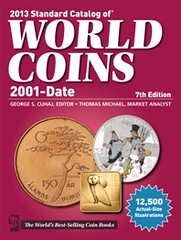 The seventh edition of the Standard Catalog of World Coins 2001-Date is now available from Krause Publications.
The seventh edition of the Standard Catalog of World Coins 2001-Date is now available from Krause Publications.
THE ORIENTAL NUMISMATIC SOCIETY
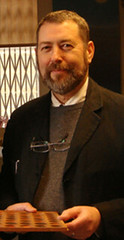 In 2009 the Oriental Numismatic Society published its 200th quarterly volume, rebranded in 2006 as the Journal of the Oriental Numismatic Society. The decision to change the newsletter's name was made in recognition of the growing status of the newsletter as an important and authoritative publication. In 2010 the Society also celebrated 40 years since its foundation by Michael Broome as a mutual association of coin collectors, curators and historians focused on the coins of Asia and North Africa. From the beginning the Society was established as an independent and informal organization, relying on its enthusiastic members to carry forward the Society's aims to promote Oriental numismatic research and collecting and improve communications between all interested in the subject.
In 2009 the Oriental Numismatic Society published its 200th quarterly volume, rebranded in 2006 as the Journal of the Oriental Numismatic Society. The decision to change the newsletter's name was made in recognition of the growing status of the newsletter as an important and authoritative publication. In 2010 the Society also celebrated 40 years since its foundation by Michael Broome as a mutual association of coin collectors, curators and historians focused on the coins of Asia and North Africa. From the beginning the Society was established as an independent and informal organization, relying on its enthusiastic members to carry forward the Society's aims to promote Oriental numismatic research and collecting and improve communications between all interested in the subject.
EL SITIO NO. 3 PUBLISHED BY THE INSTITUTO URUGUAYO DE NUMISMATICA
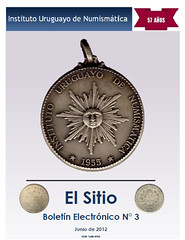 Highlights of our third publication:
Highlights of our third publication:
b) Identifying shear tokens: "Estancia San José" of Félix Eduardo Payret.
Horacio Morero and Mario Sánchez
c) The order of "Artigas": A project for a Uruguayan award.
Fernando Chao (h)
* Workshop, conference and other numismatic updates.
MONNAIE MAGAZINE AVAILABLE ON THE INTERNET
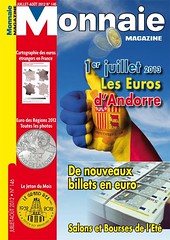 You can now read the French magazine "Monnaie Magazine," on the web and on android and ipad tablets. Videos and 360-degree images have been added to these e-versions.
You can now read the French magazine "Monnaie Magazine," on the web and on android and ipad tablets. Videos and 360-degree images have been added to these e-versions.
THE BOOK BAZARRE
COLORADO SPRINGS FIRE UPDATE
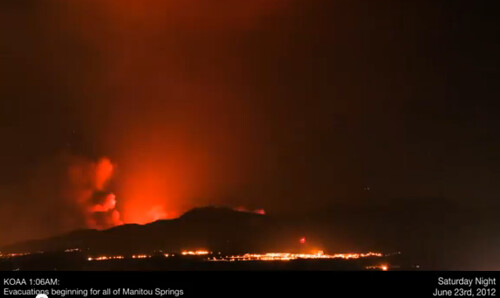
LAURENCE BROWN, 1931-2012
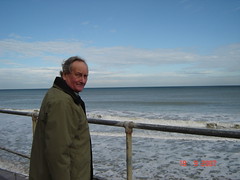 Laurence Brown, author of the definitive work British Historical Medals 1760-1960, sadly died on the 18th June. Laurence joined B.A. Seaby Ltd in 1947, later took charge of the foreign coin department and then became Managing Director. He subsequently worked for the coin department of Christie's, and when Christie's took over Spink became consultant and cataloguer for Spink, working into his late 70's.
Laurence Brown, author of the definitive work British Historical Medals 1760-1960, sadly died on the 18th June. Laurence joined B.A. Seaby Ltd in 1947, later took charge of the foreign coin department and then became Managing Director. He subsequently worked for the coin department of Christie's, and when Christie's took over Spink became consultant and cataloguer for Spink, working into his late 70's.
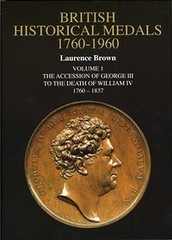
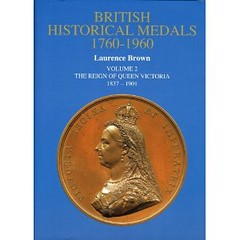
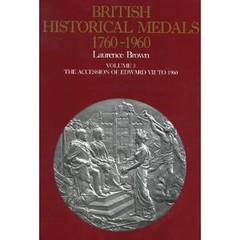 It was while doing research for his book at Windsor Castle that he noticed the Royal Collection was not then organised. He offered to take it on, working voluntarily at Windsor part time for many years until it was complete. This private work was typical of the modest gentleman we knew, who declined to have his name quoted as a reference but will be known by future generations simply as the author of BHM.
It was while doing research for his book at Windsor Castle that he noticed the Royal Collection was not then organised. He offered to take it on, working voluntarily at Windsor part time for many years until it was complete. This private work was typical of the modest gentleman we knew, who declined to have his name quoted as a reference but will be known by future generations simply as the author of BHM.
EDITH SCHÖNERT-GEIΒ, 1933-2012
NOTES FROM E-SYLUM READERS: JULY 1, 2012
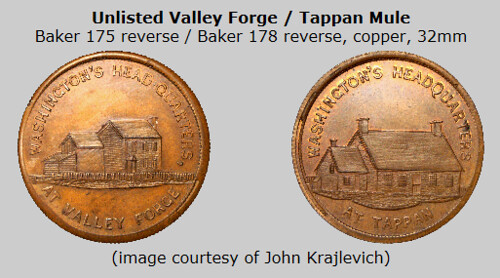
VOCABULARY PHRASE: IN GOOD NICK
MORE ON THE MEDAL OF THE MONTH
 Regarding the Medal of the Month article, I have the following
pieces. The Buranelli-Burnelli nomenclature remains a mystery to me.
Burnelli, as I recall, was designer of the innovative Flying Wing
aircraft that resembled a gigantic boomerang without the ordinary
cigar-shaped fuselage. The meeting report of the New York Numismatic
Club is also unusual as NYNC rules have stringently forbidden any hint
of commercialism since 1908... here the non-profit angle came into the
picture. Anyway, here are the descriptions of observed pieces that I
gather are the "Children's size":
Regarding the Medal of the Month article, I have the following
pieces. The Buranelli-Burnelli nomenclature remains a mystery to me.
Burnelli, as I recall, was designer of the innovative Flying Wing
aircraft that resembled a gigantic boomerang without the ordinary
cigar-shaped fuselage. The meeting report of the New York Numismatic
Club is also unusual as NYNC rules have stringently forbidden any hint
of commercialism since 1908... here the non-profit angle came into the
picture. Anyway, here are the descriptions of observed pieces that I
gather are the "Children's size":
HIDDEN COINS: HERBERT DIETZ AND MARTIN KORTJOHN
Herb was a great friend of the Stack Family who attended
most of their auctions in New York during the 1950's to
1970's. He enjoyed first reviewing the lots in our shop, and
then came on Saturdays, every month or so, to attend an
auction. Not only was he interested in assembling various
series by date and mint, but also as there were many large
lots in a number of sales, he also bought quantity. He would
take his purchases home, carefully re-examine what he won
at the sale, put them all in order, and knew what he had and
what he was still missing.
Now for the story that almost set me on my heels. We were close friends
with many of the New York and New Jersey collectors, many who were
members of the various coin clubs in the Metropolitan area. Each collector
was close to each other and we were very pleased to share their
confidence and friendship.
THE BOOK BAZARRE
DICK JOHNSON ON STOLEN VALOR: MEDAL CHEATS TRIUMPH
QUERY: IS IT STILL ILLEGAL TO BUY AND SELL MEDALS OF HONOR?
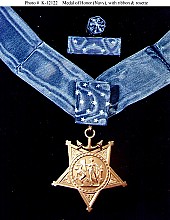 I had just finished writing this article when Dick Johnson's piece on the same topic arrived in my inbox. I decided to leave this in, as I'm not sure what the current legal status is, and like Dick I could not find much online about the topic.
I had just finished writing this article when Dick Johnson's piece on the same topic arrived in my inbox. I decided to leave this in, as I'm not sure what the current legal status is, and like Dick I could not find much online about the topic.
This week the U.S. Supreme Court struck down the Stolen Valor Act concerning military medals. All of the news stories I saw about the decision discussed the legality of lying about having been awarded the medal. While reprehensible, this was deemed free speech. But what about the provisions of the law which made illegal the buying and selling of medals such as the Medal of Honor?
Could any of our readers set us straight on what this decision means for numismatics? Can medal collectors now legally acquire these medals for their collections in the United States? The only reference I could find was the following Wikipedia entry, and it indicates that the criminal penalties for such sales have NOT been lifted, meaning that trading in the medals is still illegal.
-Editor
MORE ON THE GILBERT PAPER COMPANY
REQUEST: ELECTRONIC NBS MEMBERSHIP
QUERY: JULIO KILENYI'S CRANFORD CIVIC AWARD MEDAL SOUGHT
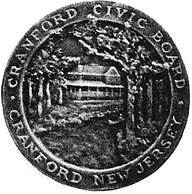 Nearly 90 years ago Cranford Police Officer James Manning was honored for pursuing and capturing a
speeding driver who had run down – and nearly killed – his fellow police officer, Edward Metzner, on the roads of Cranford.
Nearly 90 years ago Cranford Police Officer James Manning was honored for pursuing and capturing a
speeding driver who had run down – and nearly killed – his fellow police officer, Edward Metzner, on the roads of Cranford.
BRITISH MUSEUM MONEY GALLERY REOPENS
 The new Citi Money Gallery is now open. Seeing those words in front of my eyes on the computer screen still feels a little strange! Time has flown by, and I can hardly believe that I am writing this last blog post about the redisplay project.
The new Citi Money Gallery is now open. Seeing those words in front of my eyes on the computer screen still feels a little strange! Time has flown by, and I can hardly believe that I am writing this last blog post about the redisplay project.
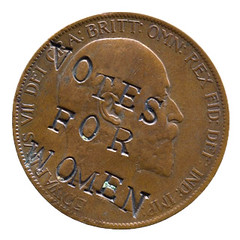 Now, then, all there is left to do is think about what I should wear to the opening event. Well, not quite. The exciting thing about the Citi Money Gallery project is that we will continue to work on the displays in the gallery after opening.
Now, then, all there is left to do is think about what I should wear to the opening event. Well, not quite. The exciting thing about the Citi Money Gallery project is that we will continue to work on the displays in the gallery after opening.
BOSTON'S MUSEUM OF FINE ARTS TO EXHIBIT ANCIENT COINS
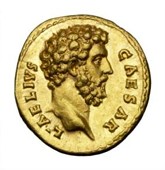 Five-hundred ancient Greek and Roman coins from the collection of the Museum of Fine Arts, Boston, will be showcased in an inaugural exhibition of its new coin gallery in September.
Five-hundred ancient Greek and Roman coins from the collection of the Museum of Fine Arts, Boston, will be showcased in an inaugural exhibition of its new coin gallery in September.
HARVEY STACK ON THE PHILADELPHIA MINT ELIASBERG COLLECTION EXHIBIT
REVAMPED PHILADELPHIA MINT EXHIBIT AND TOUR OPENS
-to-public-with-new-tour/)
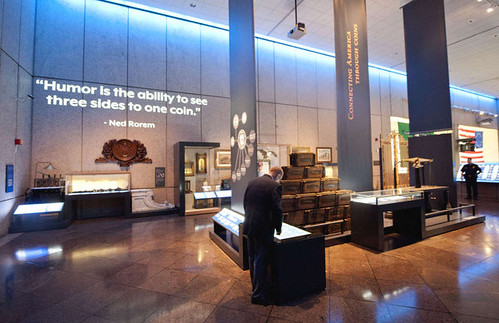
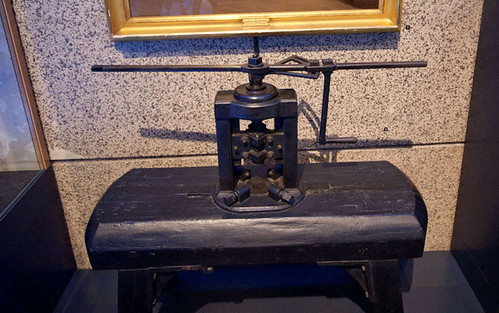
"This screw press was used to mint the first U.S. coins in 1792"
ANS AND ANA PLANNING JOINT EXHIBIT ON PHILADELPHIA MINT COINAGE
ARTICLE PROFILES DR. ARNOLD R. SASLOW
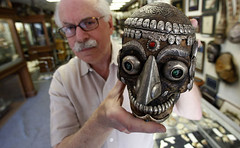 Arnold R. Saslow calls his place Ye Olde Curiositie Shoppe. It's in South Orange and it's worth a trip to get a handle on what he actually does there - but getting a handle on the man is also part of the kick.
Arnold R. Saslow calls his place Ye Olde Curiositie Shoppe. It's in South Orange and it's worth a trip to get a handle on what he actually does there - but getting a handle on the man is also part of the kick.


MASSIVE COIN HOARD UNEARTHED IN JERSEY
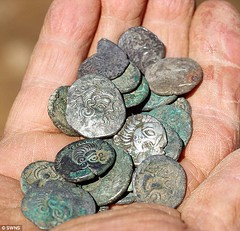 After hunting for buried treasure for three decades - and not finding a great deal - even the most diligent of us might have given up.
After hunting for buried treasure for three decades - and not finding a great deal - even the most diligent of us might have given up.
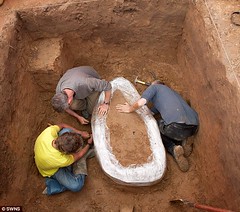

-worth-10m-discovered-Jersey-metal-detector-friends.html)
QUERY: OVERSTAMPS ON U.S. BANKNOTES
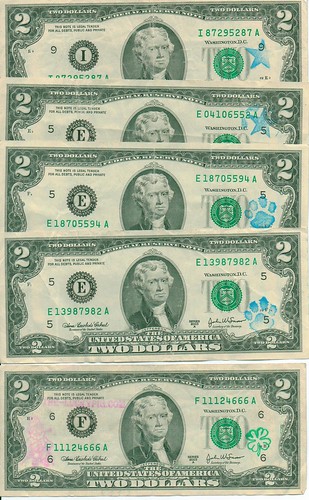
COUNTERFEIT BANKNOTES BEING SPENT IN TOURIST AREAS
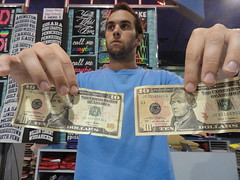 A sudden thunderstorm on Monday drove a crowd from the Ocean City Boardwalk into the Surf Mall, and a lot of money traded hands in the brief surge of shopping. Not all of it was real money.
A sudden thunderstorm on Monday drove a crowd from the Ocean City Boardwalk into the Surf Mall, and a lot of money traded hands in the brief surge of shopping. Not all of it was real money.
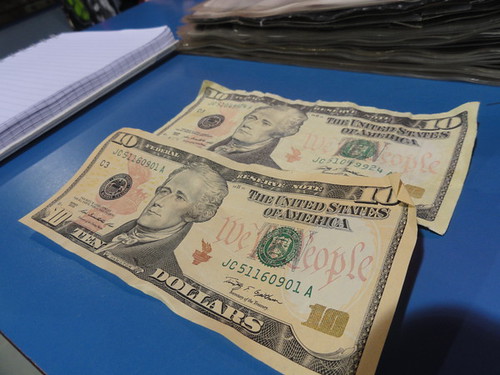
-ocean-city-boardwalk#photo-10455362)
PERTH MINT'S AUSTRALIAN KANGAROO GOLD COIN ENTERS GUINNESS BOOK
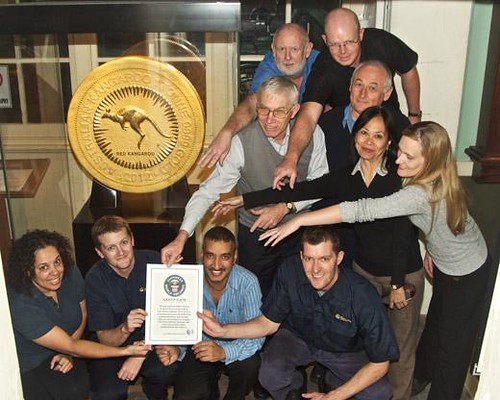
MONTROVILLE W. DICKESON'S PANORAMA ON DISPLAY IN ST. LOUIS
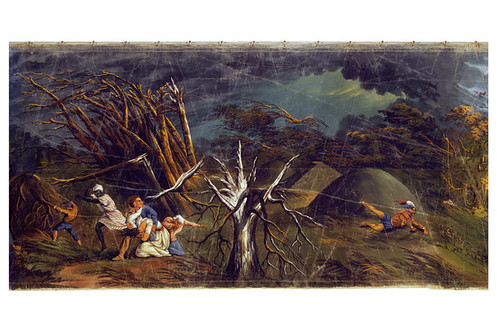
HOME LIBRARIES: BACK IN STYLE!

FEATURED WEB PAGE: BRITISH HISTORICAL MEDALS 1760-1960
This week's Featured Web Page is about British Historical Medals 1760-1960.
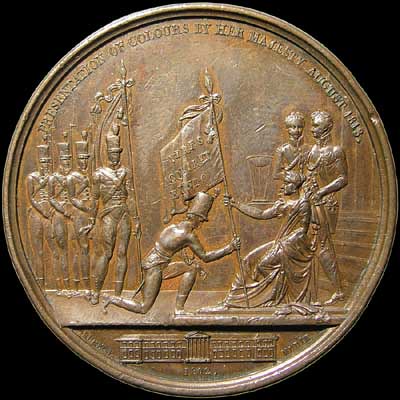
www.napoleonicmedals.org/coins/bhm.htm
